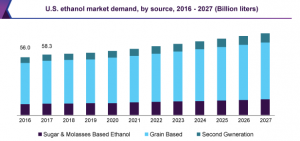Ethanol, also known as ethyl alcohol with the chemical formula C2H5OH, is an organic compound commonly referred to as drinking alcohol or grain alcohol. It is a slightly toxic, colorless, and explosive substance. Apart from its role in alcoholic beverages, ethanol serves various other purposes, contributing to the global expansion of its market.
Related Project:- Manufacturing of Ethanol (Ethyl Alcohol)

Why is the market of ethanol expanding?
Ethanol as a Solvent in Chemical Reactions
There are lakhs of chemical reactions happening in the laboratories to create new chemical compounds for various reasons. Ethanol, a readily available organic solvent, serves as a solvent in almost all kinds of chemical reactions.
Read more about the chemical industry and its growth in the coming years in our Handbook on Chemical Industries.
Additive:
Ethanol acts as an additive to automotive gasoline. People refer to the mixture as gasohol.
(Gasoline +Alcohol= Gasohol)
Preservative:
In biological fields, preserving specimens for future study is essential—whether in herbaria or zoological collections. This compound is widely used as a reliable preservative.
Flavorings:
Manufacturers widely use it as a carrier for flavors and essences in perfumes, room fresheners, and similar products.
Moreover, the rising demand for acetic acid is significantly contributing to the increased need for this compound. In particular, industries such as paints, inks, and coatings—especially in countries like South Korea and China—are driving this upward trend in market demand.
As the demand for ethanol increases alongside acetic acid, it contributes to the continued expansion of the global market, driving further growth.
Related Book:- click here for relatable books
Global Market Outlook for Ethanol and Its Applications
According to market projections, the global demand for ethanol reached 116.9 billion liters in 2020 and is expected to grow at a CAGR of 2.5% from 2021 to 2026, reaching approximately 135.5 billion liters by the end of the forecast period.
Non-fuel applications contribute 13-15% of the market, including uses in chemicals, pharmaceuticals, and the alcoholic beverage industry.
While fuel applications represent just 7% of the global market, the Asia Pacific region stands out as the largest producer and consumer of industrial-grade ethanol</strong>.
Read Similar Article: Read here.
As a key organic solvent in chemical reactions, it holds a significant share of the industrial market, with solvents making up 63%. Additionally, intermediate chemicals like acetic acid and acrylates drive nearly 17% of total demand in this sector.
Related Videos:- Chemicals (Organic, Inorganic, Industrial)
Market Analysis of Ethanol:
Experts predict the market will grow faster in Brazil, Asia, and Europe due to the demand for solvents and chemicals.
The industrial sector is expanding, with the increased use of ethyl alcohol in personal care products, cleaning supplies, and the food and beverage industries.
In North America, industrial-grade ethanol is propelling the market as a niche material. The rising use of antibacterial products, such as hand washes and sanitizers, has further boosted demand for this substance.
Access our Startup Selector Tool for detailed ethanol manufacturing business plans and market feasibility studies.
 Conclusion:
Conclusion:
Moreover, due to various factors, especially the growing demand for certain products, the global market for ethyl alcohol is witnessing consistent growth. To explore this topic further, refer to the detailed report by NPCS, which offers accurate data and comprehensive market insights.
Watch videos here: Full ethanol market plan
Frequently Asked Questions (FAQs)
1. What exactly is ethanol, and what are its basic properties?
Ethanol, also known as ethyl alcohol, is an organic compound with the chemical formula C2H5OH. It’s commonly referred to as drinking alcohol or grain alcohol. Key properties include:
- Colorless liquid
- Slightly toxic
- Explosive substance
- Readily available organic solvent
- Used in both alcoholic beverages and industrial applications
2. What is driving the expansion of the global ethanol market?
The ethanol market is expanding due to several key factors:
- Widespread use as a solvent in chemical reactions
- Growing demand as an automotive fuel additive (gasohol)
- Increased use as a preservative in biological applications
- Rising demand in the flavorings and perfume industries
- Growing need for acetic acid production
- Expansion in the paints, inks, and coatings industries, especially in Asia
3. What are the current market size and growth projections for ethanol?
According to the article:
- Global demand reached 116.9 billion liters in 2020
- Expected to grow at a CAGR of 2.5% from 2021 to 2026
- Projected to reach approximately 135.5 billion liters by the end of the forecast period
4. What is gasohol, and how does ethanol contribute to the automotive industry?
Gasohol is a mixture of gasoline and ethanol, where ethanol acts as an additive to automotive gasoline. The formula is: Gasoline + Alcohol = Gasohol
This application helps reduce dependence on pure gasoline and can improve fuel performance while reducing emissions.
5. How is ethanol used in the chemical industry?
Ethanol serves as a crucial organic solvent in chemical reactions:
- Used in laboratories for creating new chemical compounds
- Acts as a solvent in almost all kinds of chemical reactions
- Holds a significant 63% share of the industrial solvent market
- Essential for intermediate chemical production like acetic acid and acrylates (driving 17% of sector demand)


 Conclusion:
Conclusion:


